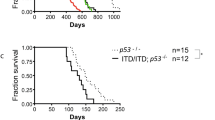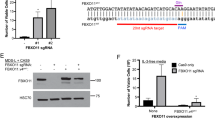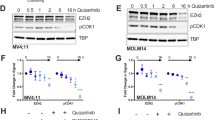Abstract
Activating mutations of FMS-like tyrosine kinase 3 (FLT3), notably internal tandem duplications (ITDs), are associated with a grave prognosis in acute myeloid leukemia (AML). Transforming FLT3ITD signal transduction causes formation of reactive oxygen species (ROS) and inactivation of the protein-tyrosine phosphatase (PTP) DEP-1/PTPRJ, a negative regulator of FLT3 signaling. Here we addressed the underlying mechanisms and biological consequences. NADPH oxidase 4 (NOX4) messenger RNA and protein expression was found to be elevated in FLT3ITD-positive cells and to depend on FLT3ITD signaling and STAT5-mediated activation of the NOX4 promoter. NOX4 knockdown reduced ROS levels, restored DEP-1 PTP activity and attenuated FLT3ITD-driven transformation. Moreover, Nox4 knockout (Nox4−/−) murine hematopoietic progenitor cells were refractory to FLT3ITD-mediated transformation in vitro. Development of a myeloproliferative-like disease (MPD) caused by FLT3ITD-transformed 32D cells in C3H/HeJ mice, and of a leukemia-like disease in mice transplanted with MLL-AF9/ FLT3ITD-transformed murine hematopoietic stem cells were strongly attenuated by NOX4 downregulation. NOX4-targeting compounds were found to counteract proliferation of FLT3ITD-positive AML blasts and MPD development in mice. These findings reveal a previously unrecognized mechanism of oncoprotein-driven PTP oxidation, and suggest that interference with FLT3ITD-STAT5-NOX4-mediated overproduction of ROS and PTP inactivation may have therapeutic potential in a subset of AML.
This is a preview of subscription content, access via your institution
Access options
Subscribe to this journal
Receive 12 print issues and online access
$259.00 per year
only $21.58 per issue
Buy this article
- Purchase on Springer Link
- Instant access to full article PDF
Prices may be subject to local taxes which are calculated during checkout







Similar content being viewed by others
References
Estey E, Döhner H . Acute myeloid leukaemia. Lancet 2006; 368: 1894–1907.
Döhner H, Estey EH, Amadori S, Appelbaum FR, Buchner T, Burnett AK et al. Diagnosis and management of acute myeloid leukemia in adults: recommendations from an international expert panel, on behalf of the European LeukemiaNet. Blood 2010; 115: 453–474.
Cancer Genome Atlas Research Network. Genomic and epigenomic landscapes of adult de novo acute myeloid leukemia. N Engl J Med 2013; 368: 2059–2074.
Naoe T, Kiyoi H . Normal and oncogenic FLT3. Cell Mol Life Sci 2004; 61: 2932–2938.
Kiyoi H, Towatari M, Yokota S, Hamaguchi M, Ohno R, Saito H et al. Internal tandem duplication of the FLT3 gene is a novel modality of elongation mutation which causes constitutive activation of the product. Leukemia 1998; 12: 1333–1337.
Breitenbuecher F, Schnittger S, Grundler R, Markova B, Carius B, Brecht A et al. Identification of a novel type of ITD mutations located in nonjuxtamembrane domains of the FLT3 tyrosine kinase receptor. Blood 2009; 113: 4074–4077.
Smith CC, Wang Q, Chin CS, Salerno S, Damon LE, Levis MJ et al. Validation of ITD mutations in FLT3 as a therapeutic target in human acute myeloid leukaemia. Nature 2012; 485: 260–263.
Stone RM, Fischer T, Paquette R, Schiller G, Schiffer CA, Ehninger G et al. Phase IB study of the FLT3 kinase inhibitor midostaurin with chemotherapy in younger newly diagnosed adult patients with acute myeloid leukemia. Leukemia 2012; 26: 2061–2068.
Tonks NK . Protein tyrosine phosphatases—from housekeeping enzymes to master regulators of signal transduction. FEBS J 2013; 280: 346–378.
Östman A, Frijhoff J, Sandin A, Böhmer FD . Regulation of protein tyrosine phosphatases by reversible oxidation. J Biochem 2011; 150: 345–356.
Lou YW, Chen YY, Hsu SF, Chen RK, Lee CL, Khoo KH et al. Redox regulation of the protein tyrosine phosphatase PTP1B in cancer cells. FEBS J 2008; 275: 69–88.
Karisch R, Fernandez M, Taylor P, Virtanen C, St-Germain JR, Jin LL et al. Global proteomic assessment of the classical protein-tyrosine phosphatome and "Redoxome". Cell 2011; 146: 826–840.
Godfrey R, Arora D, Bauer R, Stopp S, Müller JP, Heinrich T et al. Cell transformation by FLT3 ITD in acute myeloid leukemia involves oxidative inactivation of the tumor suppressor protein-tyrosine phosphatase DEP-1/PTPRJ. Blood 2012; 119: 4499–4511.
Arora D, Stopp S, Böhmer SA, Schons J, Godfrey R, Masson K et al. Protein tyrosine phosphatase DEP-1 controls receptor tyrosine kinase FLT3 signaling. J Biol Chem 2011; 286: 10918–10929.
Finkel T . Signal transduction by reactive oxygen species. J Cell Biol 2011; 194: 7–15.
Reddy MM, Fernandes MS, Salgia R, Levine RL, Griffin JD, Sattler M . NADPH oxidases regulate cell growth and migration in myeloid cells transformed by oncogenic tyrosine kinases. Leukemia 2011; 25: 281–289.
Sallmyr A, Fan J, Datta K, Kim KT, Grosu D, Shapiro P et al. Internal tandem duplication of FLT3 (FLT3/ITD) induces increased ROS production, DNA damage, and misrepair: implications for poor prognosis in AML. Blood 2008; 111: 3173–3182.
Choudhary C, Schwäble J, Brandts C, Tickenbrock L, Sargin B, Kindler T et al. AML-associated Flt3 kinase domain mutations show signal transduction differences compared with Flt3 ITD mutations. Blood 2005; 106: 265–273.
Grundler R, Miething C, Thiede C, Peschel C, Duyster J . FLT3-ITD and tyrosine kinase domain mutants induce 2 distinct phenotypes in a murine bone marrow transplantation model. Blood 2005; 105: 4792–4799.
Lambeth JD, Neish AS . Nox enzymes and new thinking on reactive oxygen: a double-edged sword revisited. Annu Rev Pathol 2014; 9: 119–145.
Nisimoto Y, Diebold BA, Constentino-Gomes D, Lambeth JD . Nox4: a hydrogen peroxide-generating oxygen sensor. Biochemistry 2014; 53: 5111–5120.
Cui Y, Riedlinger G, Miyoshi K, Tang W, Li C, Deng CX et al. Inactivation of Stat5 in mouse mammary epithelium during pregnancy reveals distinct functions in cell proliferation, survival, and differentiation. Mol Cell Biol 2004; 24: 8037–8047.
Arora D, Kothe S, van den Eijnden M, Hooft van Huijsduijnen R, Heidel F, Fischer T et al. Expression of protein-tyrosine phosphatases in acute myeloid leukemia cells: FLT3 ITD sustains high levels of DUSP6 expression. Cell Commun Signal 2012; 10: 19.
Heidel FH, Bullinger L, Feng Z, Wang Z, Neff TA, Stein L et al. Genetic and pharmacologic inhibition of beta-catenin targets imatinib-resistant leukemia stem cells in CML. Cell Stem Cell 2012; 10: 412–424.
Heidel FH, Bullinger L, Arreba-Tutusaus P, Wang Z, Gaebel J, Hirt C et al. The cell fate determinant Llgl1 influences HSC fitness and prognosis in AML. J Exp Med 2013; 210: 15–22.
Hebestreit K, Grottrup S, Emden D, Veerkamp J, Ruckert C, Klein HU et al. Leukemia gene atlas—a public platform for integrative exploration of genome-wide molecular data. PLoS One 2012; 7: e39148.
Valk PJ, Verhaak RG, Beijen MA, Erpelinck CA, Barjesteh van Waalwijk van Doorn-Khosrovani S, Boer JM et al. Prognostically useful gene-expression profiles in acute myeloid leukemia. N Engl J Med 2004; 350: 1617–1628.
Manea A, Tanase LI, Raicu M, Simionescu M . Jak/STAT signaling pathway regulates nox1 and nox4-based NADPH oxidase in human aortic smooth muscle cells. Arterioscler Thromb Vasc Biol 2010; 30: 105–112.
Yu JH, Zhu BM, Riedlinger G, Kang K, Hennighausen L . The liver-specific tumor suppressor STAT5 controls expression of the reactive oxygen species-generating enzyme NOX4 and the proapoptotic proteins PUMA and BIM in mice. Hepatology 2012; 56: 2375–2386.
Yamaji D, Kang K, Robinson GW, Hennighausen L . Sequential activation of genetic programs in mouse mammary epithelium during pregnancy depends on STAT5A/B concentration. Nucleic Acids Res 2013; 41: 1622–1636.
Rajala HL, Eldfors S, Kuusanmaki H, van Adrichem AJ, Olson T, Lagström S et al. Discovery of somatic STAT5b mutations in large granular lymphocytic leukemia. Blood 2013; 121: 4541–4550.
Kontro M, Kuusanmaki H, Eldfors S, Burmeister T, Andersson EI, Bruserud O et al. Novel activating STAT5B mutations as putative drivers of T-cell acute lymphoblastic leukemia. Leukemia 2014; 28: 1738–1742.
Kiel MJ, Velusamy T, Rolland D, Sahasrabuddhe AA, Chung F, Bailey NG et al. Integrated genomic sequencing reveals mutational landscape of T-cell prolymphocytic leukemia. Blood 2014; 124: 1460–1472.
Nicolae A, Xi L, Pittaluga S, Abdullaev Z, Pack SD, Chen J et al. Frequent STAT5B mutations in gammadelta hepatosplenic T-cell lymphomas. Leukemia 2014; 28: 2244–2248.
Hecker L, Vittal R, Jones T, Jagirdar R, Luckhardt TR, Horowitz JC et al. NADPH oxidase-4 mediates myofibroblast activation and fibrogenic responses to lung injury. Nat Med 2009; 15: 1077–1081.
Kang K, Robinson GW, Hennighausen L . Comprehensive meta-analysis of signal transducers and activators of transcription (STAT) genomic binding patterns discerns cell-specific cis-regulatory modules. BMC Genomics 2013; 14: 4.
Zhang B, Liu Z, Hu X . Inhibiting cancer metastasis via targeting NAPDH oxidase 4. Biochem Pharmacol 2013; 86: 253–266.
Stubbs MC, Kim YM, Krivtsov AV, Wright RD, Feng Z, Agarwal J et al. MLL-AF9 and FLT3 cooperation in acute myelogenous leukemia: development of a model for rapid therapeutic assessment. Leukemia 2008; 22: 66–77.
Zhang M, Brewer AC, Schröder K, Santos CX, Grieve DJ, Wang M et al. NADPH oxidase-4 mediates protection against chronic load-induced stress in mouse hearts by enhancing angiogenesis. Proc Natl Acad Sci USA 2010; 107: 18121–18126.
Kroon E, Krosl J, Thorsteinsdottir U, Baban S, Buchberg AM, Sauvageau G . Hoxa9 transforms primary bone marrow cells through specific collaboration with Meis1a but not Pbx1b. EMBO J 1998; 17: 3714–3725.
Palmqvist L, Argiropoulos B, Pineault N, Abramovich C, Sly LM, Krystal G et al. The Flt3 receptor tyrosine kinase collaborates with NUP98-HOX fusions in acute myeloid leukemia. Blood 2006; 108: 1030–1036.
Heuser M, Yun H, Berg T, Yung E, Argiropoulos B, Kuchenbauer F et al. Cell of origin in AML: susceptibility to MN1-induced transformation is regulated by the MEIS1/AbdB-like HOX protein complex. Cancer Cell 2011; 20: 39–52.
Mizuki M, Fenski R, Halfter H, Matsumura I, Schmidt R, Muller C et al. Flt3 mutations from patients with acute myeloid leukemia induce transformation of 32D cells mediated by the Ras and STAT5 pathways. Blood 2000; 96: 3907–3914.
Schmidt-Arras D, Böhmer SA, Koch S, Müller JP, Blei L, Cornils H et al. Anchoring of FLT3 in the endoplasmic reticulum alters signaling quality. Blood 2009; 113: 3568–3576.
Caldarelli A, Müller JP, Paskowski-Rogacz M, Herrmann K, Bauer R, Koch S et al. A genome-wide RNAi screen identifies proteins modulating aberrant FLT3-ITD signaling. Leukemia 2013; 27: 2301–2310.
Sun M, Xu X, Lu Q, Pan Q, Hu X, Schisandrin B . a dual inhibitor of P-glycoprotein and multidrug resistance-associated protein 1. Cancer Lett 2007; 246: 300–307.
Nishida H, Tatewaki N, Nakajima Y, Magara T, Ko KM, Hamamori Y et al. Inhibition of ATR protein kinase activity by schisandrin B in DNA damage response. Nucleic Acids Res 2009; 37: 5678–5689.
Munson JM, Fried L, Rowson SA, Bonner MY, Karumbaiah L, Diaz B et al. Anti-invasive adjuvant therapy with imipramine blue enhances chemotherapeutic efficacy against glioma. Sci Transl Med 2012; 4: 127ra136.
Zhu P, Tong BM, Wang R, Chen JP, Foo S, Chong HC et al. Nox4-dependent ROS modulation by amino endoperoxides to induce apoptosis in cancer cells. Cell Death Dis 2013; 4: e552.
Aoyama T, Paik YH, Watanabe S, Laleu B, Gaggini F, Fioraso-Cartier L et al. Nicotinamide adenine dinucleotide phosphate oxidase in experimental liver fibrosis: GKT137831 as a novel potential therapeutic agent. Hepatology 2012; 56: 2316–2327.
Naughton R, Quiney C, Turner SD, Cotter TG . Bcr-Abl-mediated redox regulation of the PI3K/AKT pathway. Leukemia 2009; 23: 1432–1440.
Hantschel O, Warsch W, Eckelhart E, Kaupe I, Grebien F, Wagner KU et al. BCR-ABL uncouples canonical JAK2-STAT5 signaling in chronic myeloid leukemia. Nat Chem Biol 2012; 8: 285–293.
Woolley JF, Naughton R, Stanicka J, Gough DR, Bhatt L, Dickinson BC et al. H2O2 production downstream of FLT3 is mediated by p22phox in the endoplasmic reticulum and is required for STAT5 signalling. PLoS One 2012; 7: e34050.
Crosas-Molist E, Bertran E, Sancho P, Lopez-Luque J, Fernando J, Sanchez A et al. The NADPH oxidase NOX4 inhibits hepatocyte proliferation and liver cancer progression. Free Radic Biol Med 2014; 69C: 338–347.
Shono T, Yokoyama N, Uesaka T, Kuroda J, Takeya R, Yamasaki T et al. Enhanced expression of NADPH oxidase Nox4 in human gliomas and its roles in cell proliferation and survival. Int J Cancer 2008; 123: 787–792.
Lee JK, Edderkaoui M, Truong P, Ohno I, Jang KT, Berti A et al. NADPH oxidase promotes pancreatic cancer cell survival via inhibiting JAK2 dephosphorylation by tyrosine phosphatases. Gastroenterology 2007; 133: 1637–1648.
Govindarajan B, Sligh JE, Vincent BJ, Li M, Canter JA, Nickoloff BJ et al. Overexpression of Akt converts radial growth melanoma to vertical growth melanoma. J Clin Invest 2007; 117: 719–729.
Prata C, Maraldi T, Fiorentini D, Zambonin L, Hakim G, Landi L . Nox-generated ROS modulate glucose uptake in a leukaemic cell line. Free Radic Res 2008; 42: 405–414.
Xi G, Shen XC, Wai C, Clemmons DR . Recruitment of Nox4 to a plasma membrane scaffold is required for localized reactive oxygen species generation and sustained Src activation in response to insulin-like growth factor-I. J Biol Chem 2013; 288: 15641–15653.
Chatain N, Ziegler P, Fahrenkamp D, Jost E, Moriggl R, Schmitz-Van de Leur H et al. Src family kinases mediate cytoplasmic retention of activated STAT5 in BCR-ABL-positive cells. Oncogene 2013; 32: 3587–3597.
Acknowledgements
We thank Drs Jack Arbiser, Carmen Döbele, Adrian Manea, Siavosh Mahboobi, Frank Schnütgen and Maya Simionescu for the kind provision of reagents. We are grateful for support by the Deutsche Akademische Austauschdienst (to AKJ), by the Deutsche Forschungsgemeinschaft to F-DB (BO 1043/10), TF and FHH (FI405/5-1), to KS (SFB815/TP1 and SCHR1241/1-1), and to AKJ (associated member of GRK 1715), by the German Jose-Carreras Leukemia Society (DJCLS SP12/08) to FHH, by the Austrian Science Fund (FWF) SFB project F4704 and F4707 to RM and PV, by the LOEWE Center for Cell and Gene Therapy by the German Cancer Consortium (DKTK) to TB and TO, the Fraunhofer Gesellschaft (graduate school translational research innovation pharma, TRIP) to KS, and the German Center for Cardiovascular Research (DZHK) to KS.
Author information
Authors and Affiliations
Corresponding author
Ethics declarations
Competing interests
The authors declare no conflict of interest.
Additional information
Supplementary Information accompanies this paper on the Leukemia website
Supplementary information
Rights and permissions
About this article
Cite this article
Jayavelu, A., Müller, J., Bauer, R. et al. NOX4-driven ROS formation mediates PTP inactivation and cell transformation in FLT3ITD-positive AML cells. Leukemia 30, 473–483 (2016). https://doi.org/10.1038/leu.2015.234
Received:
Revised:
Accepted:
Published:
Issue Date:
DOI: https://doi.org/10.1038/leu.2015.234
This article is cited by
-
STAT proteins in cancer: orchestration of metabolism
Nature Reviews Cancer (2023)
-
NADPH oxidase mediated oxidative stress signaling in FLT3-ITD acute myeloid leukemia
Cell Death Discovery (2023)
-
Effects of SIDT2 on the miR-25/NOX4/HuR axis and SIRT3 mRNA stability lead to ROS-mediated TNF-α expression in hydroquinone-treated leukemia cells
Cell Biology and Toxicology (2023)
-
Context-specific effects of NOX4 inactivation in acute myeloid leukemia (AML)
Journal of Cancer Research and Clinical Oncology (2022)
-
Gallbladder cancer-associated fibroblasts promote vasculogenic mimicry formation and tumor growth in gallbladder cancer via upregulating the expression of NOX4, a poor prognosis factor, through IL-6-JAK-STAT3 signal pathway
Journal of Experimental & Clinical Cancer Research (2020)



